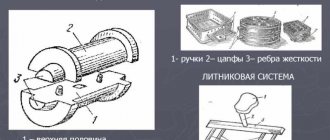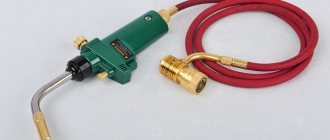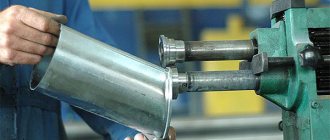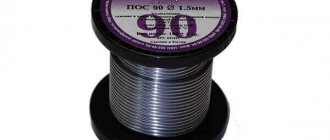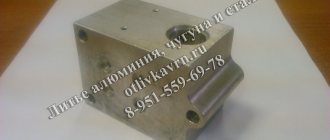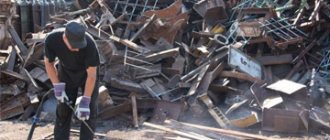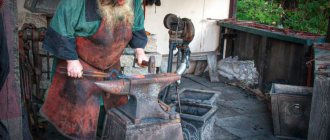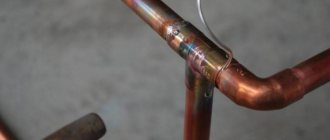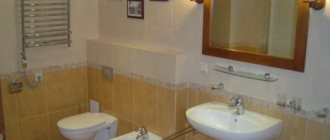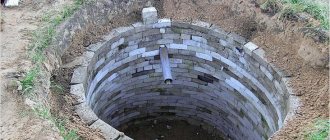Contact reaction
A type of soldering called “contact-reaction” or “reactive” means the process of fusion when two parts made of different metals come into contact.
A phase transition of the metal from solid to liquid occurs, followed by hardening and fusion. Often such a connection is made through a thin layer, which is applied to one of the workpieces by galvanic or other means.
Low-melting materials – eutectics – are used. This way you can combine silver and copper, where a copper-silver alloy will be formed between the parts. They carry out soldering of tin and bismuth, silver and beryllium, graphite and steel.
You can solder aluminum to other materials through a layer of copper or silicon. The connection is strong, soldering time takes a fraction of a second.
LIST OF MAIN AND AUXILIARY MATERIALS,
approved for use during maintenance or soldering operations
Specific tinning or soldering materials are specified for each product on the process sheets.
- Solder wire PRv KR1 or PRv KR2 POS 61 GOST 21930-76, Ø 1 mm, Ø2 mm.
- Single-channel tubular solder POS 61T1A GOST 21930-76, Ø 1 mm, Ø 2 mm.
- Multichannel tubular solder with flux that does not require cleaning, SN62 X39 f. Multicore Solders (based on alloy SN 62, silver-containing), Ø 0.56.
- Multichannel tubular solder with flux that does not require cleaning, SN60 X39 f. Multicore Solders (based on SN 60 alloy), Ø 0.7 mm, Ø 1.2 mm.
- Multichannel tubular solder with flux that does not require cleaning, JM-20 f. Koki (based on alloy SN 60), Ø 0.8 mm, Ø 1.0 mm, Ø 1.2 mm.
- Multi-channel tubular solder with no-clean flux, 60EN Crystal 502 f. Multicore Solders (based on SN 60 alloy), Ø 1.2 mm.
- Multichannel tubular solder with flux that does not require cleaning, CW-801 f. Indium (based on alloy SN 63), Ø 0.8 mm, Ø 1 mm.
- Alcohol-rosin flux FKSp OST 4G 0.033.200.
- Solid flux “pine rosin grade “A”” GOST 19113-84.
- One-component flux, no cleaning required, X33-12i (MF-210) f. Multicore Solders or WF-9942 f. Indium.
- Ethyl alcohol GOST 18300-87.
- Nefras S2 80/120 TU 38 401-67-108-92
- Flushing liquid VIGON EFM f. Zestron.
- Silver braid for removing solder (outer conductor of radio frequency cable RK-75-1-22 TU 16.505.198-91) or copper braid DESOLDERING WICK or similar.
- Round panel brush KFK No. 8, No. 12 GOST 10597-87.
- Flat panel brush KFP No. 8, No. 12 GOST 10597-87.
- Artistic brush KHZhK No. 1, No. 3 “squirrel” OST 17880-80.
- Cotton scraps art. 361 GOST 4644-75.
- Knitted gloves with polymer coating, Multex type code Per 306 according to catalog f. Tract.
- Antistatic gloves ESD CLOVES 8745 PVCB 6.
- TTC-LF paste or similar for cleaning and tinning tips.
Ultrasonic soldering
Another modern high-tech soldering method, the development of which was caused by the need to eliminate a number of characteristic disadvantages of electrochemical joining methods. A key feature of this technique is the ability to replace conventional flux as a means of removing oxides. The stripping function is performed by the energy of ultrasonic waves, which causes cavitation in the liquid solder. At the same time, the tasks of thermal binding action from the melt are fully preserved.
The superiority of the technology in terms of connection speed is also noted. If we compare ultrasonic radiation with the effect that tin-lead solder gives, then the intensity of the slamming of the cavities of the processed unit will be several times higher. As observations show, ultrasonic waves with a frequency of 22.8 kHz provide a solder closing speed of 0.2 m/s.
There are also economic advantages of this method. They are also associated with changes in approaches to the use of fluxes and solders. In the production of electrical devices, when assembling monolithic capacitors, current converters and other devices, metallization with palladium, silver and platinum pastes is widely used. The ultrasonic soldering process allows you to replace precious metals with cheaper analogues without losing the performance of the future product.
Copper pipe soldering technology
Copper is easy to process. It does not need to be cleaned with aggressive agents. The metal has good adhesion to low-melting alloys. Therefore, suitable solder is not difficult to find.
Soldering copper water pipes
Connecting copper parts is done in two ways. Regardless of the option, there is no need to use expensive fluxes, since a violent reaction with oxygen does not occur when the metal begins to melt.
High temperature soldering
The connection is made at temperatures above 450°C and using solders made of refractory metals, which include copper and silver. The method makes it possible to obtain solid compounds.
When performing high-temperature soldering, the metal is softened by annealing, and the created seam is cooled naturally. This allows you to preserve the strength properties of copper as much as possible.
Using hard soldering, products with a diameter of 12-159 mm are connected. This method is used for gas pipeline networks. The high-temperature method also allows you to connect water pipes with a diameter exceeding 28 mm. The solid method is also used if the temperature of the medium in the pipelines is more than 120°C. The high-temperature soldering option is perfect for creating bends in a heating network without disassembling the thermal circuit.
Low temperature soldering
This method is called soft connection. It is carried out at temperatures less than 450°C. The process uses solders made of low-melting metals, lead and tin.
The low-temperature connection option allows you to create seams with a width of 7-50 mm. Such joints are less durable compared to joints made using the high-temperature method. Therefore, soft soldering is not used for gas communications.
The low temperature method does not anneal the copper. Therefore, the strength of the metal does not change. Soft soldering is used when installing pipes with a diameter of 6-108 mm. This method is also suitable for plumbing and heating systems if the temperature of the heated medium does not exceed 130°C.
Solderingis the process of obtaining a permanent connection of materials by their autonomous melting during wetting, spreading and filling the gap between them, followed by its crystallization.
Advantages of soldering:
- Allows you to connect metals in any combination;
- The connection is possible at any initial temperature of the soldered metal;
- It is possible to combine metals with non-metals;
- Soldered joints are easily removable;
- The shape and dimensions of the product are more accurately maintained, since the base metal does not melt;
- Allows you to obtain connections without significant internal stresses and without warping of the product;
- Increased productivity of the process allows you to solder a large number of products in one go;
- Production culture; Full mechanization and automation is possible.
1 - crystallization layer of variable chemical composition;
2 - diffusion zone with variable chemical composition;
3 - area with variable structure and properties as a result of local heating
4 – zone of isothermal crystallization.
Figure 1. Solder joint structure
Terms and Definitions:
Solder
- a metal or alloy introduced into the gap between the parts or formed between them during the soldering process and having a lower temperature of the onset of autonomous melting than the soldered materials.
Solder joint
- an element of a soldered structure consisting of:
a) soldered seam and diffusion zones during general heating;
b) a soldered weld from the HAZ with local heating.
Solder seam fillet
- a section of a soldered seam formed as a result of the action of capillary forces at the edge of the gap on the outer surfaces of the parts being connected.
Diffusion zone
- a section of a solder joint characterized by a changed chemical composition of the base material and formed as a result of the diffusion of solder components.
Soldering classification
Types of capillary soldering:
- Soldering with ready-made solder is capillary soldering, in which ready-made solder is used and the formation of a seam occurs as it cools.
- Contact-reactive capillary soldering, in which solder is formed as a result of contact-reactive melting of the materials and gaskets being connected.
- Reactive flux capillary soldering, in which solder is formed as a result of the release of metal from the flux.
- Diffusion capillary soldering, in which the solidification of the soldered seam occurs above the solidus temperature of the solder without cooling.
- Metal-ceramic capillary soldering, in which the metal filler of the ceramic solder forms a branched capillary that holds the liquid part of the solder outside the capillary gap during soldering.
Types of non-capillary soldering:
- Solder welding is carried out without melting parts.
- Welding and soldering is used for soldering metals with different melting temperatures, with the metal with the lowest melting point performing the function of solder.
All soldering methods are divided into:
- According to physical, chemical, electrochemical characteristics that determine the process of removing oxides from the surface of the soldered metal:
- flux;
- ultrasonic;
- in an active gas environment;
- in a neutral gas environment;
- in a vacuum.
- By type of heating:
- 450 0С for low-temperature soldering;
- when the temperature rises, any heating sources.
- Based on the absence or presence of pressure on the soldered parts:
- no pressure;
- under pressure.
- By heating time:
- simultaneously;
- not simultaneously.
The formation of a solder joint is accompanied by a weld between the solder and the soldered material.
Spay
- a transition layer formed as a result of wetting at soldering temperature and subsequent interaction at the “base metal solder” boundary.
Classification of junctions:
- Non-diffusion - when atoms do not cross the contact boundary.
- Solution-diffusion - when the base metal dissolves in the solder and dissolves the solder elements.
- Contact-reaction - occurs without solder due to contact melting of the base metal.
- Dispersed - formed between metals that do not form a chemical compound with each other and are insoluble in each other due to a strong decrease in surface tension under the influence of solder and dispersed solid particles.
Structural parameters of solder joints (Figure 2)
- Connection type;
- Solder gap;
- The amount of overlap;
- Surface roughness;
- Radius of fillet area;
- Edge bevel angle.
Figure 2
Solders and soldering mixtures. Requirements for them:
- The melting temperature of the solder must be lower than the melting temperature of the metal being soldered;
- Solder must have good fluidity, wet metal surfaces, spread, and penetrate narrow gaps;
- Solder must form an alloy with the materials being joined and provide a strong bond;
- The corrosion resistance of soldered seams of the material must be the same in order to avoid electrocorrosion;
- The thermal coefficient of linear expansion (TCLE) of the solder and the base metal must be the same to avoid residual stresses and cracks;
- Solder should not significantly reduce the strength and ductility of the materials being joined;
- Electrical conductivity, thermal conductivity and other physical and chemical properties of the solder and the base metal should not differ much.
Solder classification:
- According to the chemical composition.
- According to technological properties:
- self-fluxing solders - which remove oxides from the soldered surface without the participation of flux;
- composite solders - consisting of a mixture of refractory and low-melting elements.
- According to the content of activating components that increase wettability.
- By melting point:
- low-temperature (melting temperature of solder is less than 450 0C);
- high-temperature (melting temperature of solder is more than 450 0C).
- By assortment:
- ductile solders:
strip; - foil;
- wire.
- brittle solders:
- rods;
- castings;
- powders;
- pastes;
- net;
- shavings;
- rings;
- briquettes
Classification of fluxes:
- Based on temperature:
- low temperature;
- high temperature.
- By the nature of the solvent:
- aquatic;
- non-aquatic
- By the nature of the activators:
- low temperature:
halide; - fluoroboride;
- boride carbon dioxide.
- high temperature:
- rosin;
- fluoride;
- stearic;
- acidic;
- hydrozine;
- animine.
- According to the mechanism of action:
- protective;
- chemical action;
- electrochemical action;
- reactive.
- According to the state of aggregation:
- hard;
- liquid;
- pasty.
Fluxing mechanisms:
- Chemical reactions of flux components with oxide:
- formation of metal reduction;
- formation of light complex compounds.
- Electrochemical reactions - ionic destruction of the base metal.
- Due to physical processes, as a result of chemical reactions.
Flux composition:
- A base that dissolves fluxing products (borax, light metal chlorides, borax + boric anhydride);
- Oxide film solvents (fluorides);
- Active reagents (salts of heavy metals, oxides giving complex compounds).
Fluxes are divided into 4 groups:
- Based on rosin and other organic compounds (for low-temperature soldering, when it is difficult to rinse the part after soldering);
- Based on chloride compounds (for soldering low-melting metals with a strong oxide film), the base is low-melting eutectic;
- Based on boron compounds (for soldering cast iron, copper and alloys based on it);
- Based on fluorine compounds (for soldering austenitic steels, nickel and alloys based on it).
Gas media:
- Vacuum:
- low P<10-1 mmHg. — not applicable for soldering;
average P<10-4 mmHg. — for soldering bronze, steels of all classes, nickel;
- - high P>10-4 mmHg. - for soldering titanium, tantalum, zirconium, niobium.
- Neutral media: gases that are inert with respect to the base metal and solder. The mechanism of action of a neutral environment on the oxide film is to reduce the partial pressure of oxygen on the base metal.
- Active (reducing) media: active (hydrogen, nitrogen (ammonia at a temperature of 650 0C decomposes into nitrogen and hydrogen). The mechanism of action of the active medium on the oxide film is the chemical interaction of the active gas with the oxides of the base metal.
Note: P is the degree of rarefaction. The mechanism of the effect of vacuum on the oxide film is to reduce the partial pressure of oxygen on the base metal.
Infrared stations and hair dryers
Models of hot-air soldering equipment (hair dryers) are used mainly for dismantling and volumetric mounting of microcircuits on electronic device boards. Very often, a hair dryer is included in the package of a soldering station, which also consists of an electric soldering iron and a control unit.
The soldering station allows you to install and control the parameters of the tools included in it, ensuring high quality seams.
Often, the equipment for a soldering station includes a table with the ability to heat parts or circuit boards from below.
This installation uses infrared heat sources - lamps, heating elements. Some designs of heating tables are equipped with brackets and stands, which allow you to secure the boards.
Infrared equipment has a similar effect to a soldering gun. It can also be used to provide heating of a large area without allowing contact with microcircuit elements.
Infrared soldering stations allow you to control soldering and ensure smooth cooling of the metal. This is expensive equipment, which consists of entire computing systems with sets of sensors, processors and a whole list of auxiliary tools.
Industrial soldering
Heavy industry enterprises use completely different types of soldering equipment. The joining of large parts and structures in industrial conditions occurs in furnaces.
In this case, the highest quality is achieved, since when using furnace equipment, you can constantly monitor the condition of the metal and maintain the required temperature and pressure. Metal is protected from oxidation by introducing fluxes into the furnace chamber.
Soldering ovens vary in heating principle. They are induction, gas, electric. Workpieces are fed and removed in various ways depending on the design of the furnace equipment. This can be manual feed, belt conveyor, mine and elevator feed.
In manually fed furnaces, heating and cooling of parts and the soldering chamber occurs within one soldering cycle. After cooling, new parts are loaded. In this furnace it is easiest to control the process and its duration.
In conveyor soldering equipment, heating occurs constantly, and parts cool down after removal from the chamber. Such furnaces are used to create a large number of identical, serial products.
Shaft and elevator furnaces are used for the manufacture of large-sized volumetric structures, which are assembled directly in the furnace and then carry out the soldering process under fully controlled parameters.
Vacuum soldering equipment is used to join products made from highly oxidizing materials. Brazed seams produced in such furnaces are clean and uniform, which ensures their strength.
Due to the lower temperature and completely different impact on the metal than during welding, solder joints are more resistant to corrosion and mechanical stress.
Soldering of metals, the essence of the process.
Soldering is the technological process of joining metals in the solid state with solders, which, when melted, wet the soldered surfaces and penetrate the base metal, filling the capillary gap between them and forming a soldered seam.
From the above it follows that the process of formation of a solder joint is associated with heating. To obtain a junction, along with heating, it is necessary to provide two more basic conditions: remove the oxide film from the surface of the metals during the soldering process and introduce a molten binder metal into the connecting gap between them. When cooling (crystallization) of a more fusible binding metal that has interacted with the soldered metals, a solder joint is formed.
The materials that are soldered are called soldered, joined, or base materials. A metal or alloy that has a lower melting point is introduced between them for connection and is called solder.
The process of soldering metals has much in common with welding, and above all with fusion welding, but, despite the external similarities, there are fundamental differences between them.
If during fusion welding the welded metal and the filler metal in the weld pool are in a molten state, then during soldering the soldered metal does not melt. Forming a joint without melting the edges of the parts being soldered is the main feature of the soldering process.
When soldering, the formation of a seam occurs by filling the capillary gap between the parts being connected with solder, i.e., the soldering process is associated with the capillary flow of the filler metal, which does not occur during fusion welding.
And finally, soldering, unlike fusion welding, can be carried out at any temperature below the melting point of the base metal. These differences have a different nature than in fusion welding of the processes occurring during the formation of a soldered seam.
Modern soldering methods cover a wide range of materials: carbon, alloy and stainless steels; hard, non-ferrous and special alloys.
Depending on the solders used, there are two types of soldering, differing in the melting point and mechanical strength of the solders; soft soldering and hard soldering.
Soft solders have a melting point below 400 °C and produce a joint that does not provide high mechanical strength to the seam. Hard soldering is carried out using solders that have a melting point of over 700 °C and provide high mechanical strength and temperature resistance of soldered joints.
Before soldering, the parts are thoroughly cleaned of dirt, scale, etc. and fit tightly together. Then the joints are degreased, coated with etched hydrochloric acid. If the presence of acid residues cannot be allowed on the parts to be soldered, then degreasing is carried out with rosin diluted in alcohol: alcohol degreases the soldered surface, and rosin protects it from oxidation. The soldering results in a clean and even finish. For soldering with soft solders, soldering irons made of red (pure) copper are used. A copper soldering iron heats up well and retains heat for a long time. Soldering irons are heated by electric current, as well as by the flame of a blowtorch, gas burner, in ovens, etc.
To solder two surfaces with soft solder, they are connected and flux is applied to the soldering areas. Then a drop of molten solder is placed on the end of a heated and tinned soldering iron and introduced into the gap of the surfaces to be joined. The solder quickly cools, solidifies, and the soldered parts are joined together, forming a tight and durable connection called a seam.
Preparation and brazing are more difficult. Here, flux is applied to the cleaned surfaces, pieces of solder are applied and tied with wire, and then heated with a blowtorch flame or other means. Heating is carried out until the solder melts and floods the junction area. After soldering is completed, the connection is allowed to cool, after which the flux residues are slowly removed, solder deposits are cleaned off, etc. To remove flux residues, the part is washed in cold or hot water, in special solutions, or cleaned with a file, wire brush, blown with sand, etc. .
Rosin fluxes are not soluble in water, and alcohol, gasoline or trichlorethylene are used to remove them. Since such fluxes do not cause corrosion, their removal from the surface of the weld is not always necessary.
Soldering Features
Features of the technological process depend on the characteristics of the elements being connected. Let's look at some types of metals.
Steel
Soldering of steel is performed with tin-based solders, without any exceptions. Before performing work, you should first prepare the surface using mechanical treatment. Cleaned parts are degreased. After this, the elements are joined with a gap of no more than 3 mm. A distinctive feature of working with steel is the method of heating the solder. It should receive heat not from the burner, but from the workpieces themselves. Upon completion of work, it is necessary to remove any remaining consumables from the surface.
Cast iron
Any type of cast iron can be processed, with the exception of white. This metal contains graphite, which reduces adhesion. Therefore, boric acid must be used as a flux.
When working with cast iron, it is prohibited to exceed the temperature threshold of 750 Cº. Otherwise, an irreversible process of changing the structure of the metal will begin.
Titanium
Soldering titanium is considered one of the most difficult jobs. This is due to its surface layer, which is saturated with various gases. As a preliminary preparation, etching or sandblasting is used.
Experts recommend soldering in a vacuum environment to improve the quality of the connection. For unprotected work, use silver flux.
Work is carried out at a temperature of 900 Cº.
Nichrome
This metal does not cause problems. Nichrome is an alloy of nickel and chromium. It is characterized by plasticity and high heat resistance. Its melting point is in the range of 1100-1400 Cº, which allows you to choose any suitable solder.
Silver
Soldering silver can be done not only by a professional jeweler, but also by an ordinary person who has never had to deal with jewelry repair. For soldering, refractory silver solder and borax are used as a flux.
Upon completion of the work, you can treat the product with citric acid or iodine. In the first case, the decoration will lighten, and in the second, it will acquire a dark shade.
Gold
Repairing expensive jewelry is a delicate process. In case of damage to gold items, we recommend contacting a qualified specialist. To make the connection, special tools and special solder are required.
It is not advisable to buy expensive equipment for one-time work.
Copper
This metal is absolutely not demanding on fluxes. Zinc chloride or an alcohol solution of rosin are best. But you need to be careful with solder: tin increases the fragility of the connection, lead adds viscosity, so we recommend using silver-based compounds.
The operating temperature should not exceed 900 Cº.
Solder
Soldering solders that fill the gap in the molten state between the workpieces being joined must meet the following requirements:
- their melting temperature must be lower than the melting temperature of the materials being soldered;
- they should wet the soldered material well and spread easily over its surface;
- must be sufficiently durable and airtight;
- the thermal expansion coefficients of the solder and the material being soldered should not differ sharply;
- have high electrical conductivity when soldering radio-electronic and conductive products.
Solders are classified according to the following criteria:
- A) Chemical composition;
- B) Melting temperature;
- B) Technological properties;
Based on their chemical composition, solders are divided into lead-tin, silver, copper-phosphorus, zinc, titanium, etc.
All solders are divided according to their melting point into low-temperature (tm<500oC), or soft solders, and high-temperature (tm>500oC), or hard solders. Solders are manufactured in the form of rods, wires, sheets, strips, spirals, rings, disks, grains, etc., placed at the joint.
Low-temperature or soft solders include tin-lead solders based on bismuth, indium, cadmium, zinc, tin, and lead. High-temperature or hard solders include copper, copper-lead, copper-nickel, and noble metals (silver, gold, platinum).
Based on technical properties, they are divided into self-fluxing (partially removes oxides from the metal surface) and composite (consisting of refractory and low-melting powders, allowing soldering with large gaps between parts).
Products made of aluminum and its alloys are soldered with aluminum-based solders with silicon, copper, tin and other metals.
Magnesium and its alloys are soldered with magnesium-based solders with the addition of aluminum, copper, manganese and zinc.
Products made of corrosion-resistant steels and heat-resistant alloys operating at high temperatures (>500°C) are soldered with solders based on iron, manganese, nickel, cobalt, titanium, zirconium, hafnium, niobium and palladium.
Features of soldering with an electric soldering iron
Soldering with an electric soldering iron has a number of features compared to other connection methods. They must be taken into account when performing installation work.
Important! When working at home, try not to inhale fumes from a soldering iron. The smoke from rosin is relatively safe
And acid vapors are not at all beneficial for the respiratory system and lead to coughing. If there is no special hood, then soldering should be done with the windows open.
Flux selection
Most often, electricians use solid flux - rosin. There are two ways to apply it to the wires to be soldered:
The soldering iron tip touches the rosin pebble. The flux is then transferred from the heated tip of the tool to the wires being soldered.
It is important to have time to apply rosin to the current-carrying conductor before it evaporates from the tip. Usually this is 3-5 seconds. The stripped wire is placed on rosin and pressed on top with a heated tip.
In this case, the flux melts and the wire is immersed in the melt.
Rosin can be mixed with ethyl alcohol. The result is a good liquid flux, which is convenient to apply with a brush.
It is important not to overdo it here so that the solution does not flow down the wire insulation. After all, in the future dust will stick to this place
Soldering stranded wires
Stranded wire is a set of thin wires woven into one cable and covered with insulation. Such a conductor is easier to solder than a monolithic one. Any type of flux readily penetrates and is drawn into the voids between the thin wires of the core. This also applies to solders. They easily impregnate stranded wire. The main thing is to warm it up properly, and soldering will proceed by itself. To solder the wires securely, they must be carefully twisted with your fingers.
Soldering junction boxes using a crucible
This method allows you to conveniently solder twists that are in boxes and socket boxes. The solder is pre-melted in a small crucible with a volume of 20 to 100 ml. The wires to be soldered are immersed in a container of molten metal.
A compact gas burner is used to heat the crucible and melt the solder. Some experts use homemade devices for these purposes, made with their own hands from powerful electric soldering irons. But such devices require voltage, which is not always present in the apartment being renovated.
Flux for soldering aluminum
When soldering with regular rosin, the solder will not stick to the aluminum. Here you need to use a flux like F-64. It is produced specifically for aluminum wires. The product is sold in liquid form in the form of a jar with a brush.
After soldering with F-64, the twist must be washed with a slightly alkaline solution to neutralize the acidic properties of the flux. To obtain a cleaning mixture, simply dilute baking soda in warm water. Then you need to wash it with plain soapy water or liquid soap using a toothbrush.
Soldering allows you to reliably connect wires at minimal cost. All you need: soldering iron, solder and flux. A properly soldered contact will last no less than the wiring itself.
You should choose a soldering iron based on the power of the heater. The maximum thickness of the wires that can be connected depends on this criterion. The type of flux, solder, shape and material of the soldering iron handle are selected based on the individual preferences of the master.
How to solder wires correctly: choosing a soldering iron, fluxes and solders, soldering technology
0,00 / 0
Guru 220→Electrical wiring→Wires and cables→
Did not you find what you were looking for? See also:
- Homemade LED spotlight at home
- Options and nuances of connecting stranded and single-core wires
- Technology of tinning conductors - overview of methods
- Using a soldering iron and connectors to connect LED strips
- How to strip wires - an overview of tools
- Methods for terminating cable cores and wires using lugs
Add a comment Cancel reply
–
2016-2020. 220 GURU All rights reserved
- Site Map
Copying materials without permission from the site administration or the author is prohibited.
Varieties
Soldering happens
- low temperature (heating solder to 450 °C);
- high temperature (heating the solder over 450 °C).
Accordingly, there are solders
- fusible;
- refractory.
For low-temperature soldering, mainly electric heating is used, for high-temperature soldering, mainly heating with a torch is used. Alloys are used as solder
- tin-lead (Sn - 90%, Pb - 10%, temperature pl. 220 °C);
- copper-silver (Ag - 72%, Cu - 28%, temperature pl. 779 °C);
- copper-zinc (Cu - 48%, Zn - 52%, temperature pl. 865 °C);
- gallium (t° pl. ~50°C);
- bismuth (Wood's alloy with a temperature of 70 °C, Rose's alloy with a temperature of 96 °C)
- etc.
Soldering is a highly productive process, provides a reliable electrical connection, allows you to join dissimilar materials (in various combinations of metals and non-metals), and lacks significant temperature distortion (compared to welding). Soldered joints allow repeated separation and connection of the parts being connected (unlike welding). Disadvantages include relatively low mechanical strength.
Based on the physicochemical nature of the process, soldering can be defined as follows. The process of joining metals in a solid state by introducing solder into the gap, interacting with the base metal and forming a liquid metal layer, the crystallization of which leads to the formation of a solder seam. At the boundary between the solder and the base metal, transition layers are formed, consisting of the products of their interaction - solid solutions and intermetallic compounds. They provide adhesion between the solder and the base metal, but too thick layers of intermetallic compounds are brittle and lead to solder failure.
Types of soldering:
- capillary (wetting of parts and flow of solder into the gap between them occurs due to capillary forces): horizontal;
- vertical;
- atomic diffusion;
- with the formation of eutectic;
- no solder;
- without reflow;
Analyzing the essence of the physical and chemical processes occurring at the boundary of the base metal - molten solder (when forming a joint in existing types of soldering), one can see that the differences between capillary soldering, diffusion soldering and soldering-welding are not fundamental. Capillarity is a common feature of soldering. A distinctive feature of diffusion soldering is a long exposure at the soldering temperature and isothermal crystallization of the weld metal during the soldering process. This method has no other characteristic features; its main purpose is to increase the temperature of the seam and the strength of the soldered joint. Diffusion soldering can be a development of any type of soldering, including capillary, reaction-flux or contact-reaction. In the latter case, diffusion soldering is possible if the second metal of the interacting pair is introduced as a layer between the metals being joined. During reaction-flux soldering, the processes of displacement of the metal serving as solder from the flux and its interaction with the base metal are combined. Finally, soldering-welding differs from other soldering methods in the amount of solder introduced and the nature of the formation of the seam, making this soldering method similar to fusion welding. When connecting dissimilar metals during soldering and welding, the edge of one of the parts made of a lower melting metal may melt.
Explain the purpose and essence of metal soldering. Briefly describe soft and hard soldering
Soldering is a technological operation used to obtain a permanent connection of parts made of different materials by introducing between these parts a molten material (solder) that has a lower melting point than the material (materials) of the parts being connected. The parts to be soldered, as well as solder and flux, are brought into contact and subjected to heating at a temperature above the melting point of the solder, but below the melting temperature of the parts being soldered. As a result, the solder goes into a liquid state and wets the surfaces of the parts. After this, the heating stops and the solder goes into the solid phase, forming a connection. The strength of the connection largely depends on the gap between the parts being connected (from 0.03 to 2 mm), the cleanliness of the surface and the uniform heating of the elements. Fluxes are used to remove the oxide film and protect against atmospheric influences. There are soldering
soft, or low-melting, and hard, or refractory, solders.
The melting point of soft
solders does not exceed 400-450°C.
Therefore, this type of soldering requires the simplest heating sources and is characterized by simplicity of technology. When soldering with soft solders, reliable and airtight seams are obtained. But they have low mechanical strength (5-7 kg/mm2) and can operate at temperatures not exceeding 200° C. Soft soldering is widely used to obtain tight seams in dishes, tanks, reservoirs, for connecting wires and parts in radio and electrical engineering. To obtain a seam using hard solders,
special heating devices are required (forges, chamber furnaces, high-frequency current installations). The seam is more durable and can operate at elevated temperatures. Brazing is used for soldering carbide strips onto tools, connecting pipelines, bicycle frames, etc.
Explain the purpose and essence of metal cutting. List the main groups of instrumental materials and explain what the main requirements for them are. Describe the use of various types of metal cutting in the production and repair of rolling stock.
Machining of metals by cutting involves cutting off a layer of metal from the workpiece being processed - an allowance specially left for processing in order to obtain a part of a given shape, size and roughness. Types of cutting processing: 1. On rolling machines; 2. On planing machines; 3. Drilling machines; 4. Grinding machines; 5. Polishing machines. Cutting tools made from carbon tool steels have sufficient hardness, strength and wear resistance at room temperature, but their heat resistance is low. At temperatures of 200 - 2500 their hardness decreases sharply. Therefore, they are used for the manufacture of hand and machine tools intended for processing soft metals with low cutting speeds, such as files, small drills, reamers, taps, dies, etc. Tool materials are divided into the following groups: tool steels; hard alloys (cermets); synthetic boron nitride compositions; synthetic diamonds. Tool steels are divided into: carbon (used for the manufacture of tools operating at low cutting speeds), alloyed (Alloy tool steels are chromium (X), chromium-silicon (XS), tungsten (B) and chrome-tungsten-manganese (HVG), etc.) and high-speed (High-speed steels are used for the manufacture of various tools, but more often drills, countersinks, and taps).
List and explain the main types of cutting of metals and alloys. Describe the final process of metal cutting and provide characteristics of abrasive materials used in grinding.
Machining of metals by cutting involves cutting off a layer of metal from the workpiece being processed - an allowance specially left for processing in order to obtain a part of a given shape, size and roughness. Types of cutting processing: 1. On rolling machines; 2. On planing machines; 3. Drilling machines; 4. Grinding machines; 5. Polishing machines.
Soldering
When the soldering area is hot enough, you can add solder. It is introduced in two ways - molten, in the form of a drop on the soldering iron tip, or in solid form (solder wire) directly into the soldering zone. The first method is used if the soldering area is small, the second - for large areas.
If you need to add a small amount of solder, touch it with the soldering iron tip. There is enough solder if the tip turns white and not yellow. If a drop hangs, this is too much, it must be removed. You can tap the edge of the stand a couple of times. Then they immediately return to the soldering zone, running the tip along the soldering area.
How to solder correctly with a soldering iron: the second method of adding solder
In the second case, we insert the solder wire directly into the soldering zone. When heated, it begins to melt, spreading and filling the voids between the wires, taking the place of evaporating flux or rosin. In this case, you need to remove the solder in time - its excess also does not have a very good effect on the quality of soldering
In the case of soldering wires this is not so critical, but when soldering electronic elements on boards it is very important
Features of soldering and welding
Soldering as such has many similarities with traditional welding technologies. Heating of the workpieces and third-party material are also used to influence the formation of the seam. But, compared to welding techniques, soldering does not involve internal melting of the workpiece structure. The edges of the parts, as a rule, remain hard, although they are subject to heating. Still, complete melting of the workpiece produces a stronger connection. Another thing is that to achieve such a result, more powerful equipment may be required. When using liquid solder for copper, non-capillary soldering with dense filling of the seam is quite feasible. This joining method is partially related to welding, since it increases the adhesion of the structures of two or more workpieces. It is recommended to perform non-capillary soldering using electric arc devices or an oxygen-acetylene torch.
Soldering-welding
The technology received this name because the process itself is very similar to welding metal with filler material (wire or powder).
But in this case, solder is used instead of an additive. This type is most often used to repair defects and flaws on the surfaces of metal parts (cast).
The process itself can be carried out in different ways:
- soldering in furnaces;
- dipping into a bath of liquid solder;
- resistance using electric current;
- inductively;
- radiation;
- using soldering irons and gas torches.
Some species appeared relatively recently and are still being researched and refined.
In the ovens
The first option ensures uniform distribution of solder over defective areas of the part and uniform heating, which is especially important when you have to solder large workpieces with complex configurations.
In this case, heating in a furnace can take place in one of many existing ways, ranging from flame heating to complex technological processes, such as induction, electrical resistance.
The design of the furnaces themselves differs from each other only in the hearths on which the soldered workpieces are placed. For large parts, ovens are used in which the oven does not move, and for small parts, ovens are used in the form of conveyors on rollers.
The main task of this type of soldering is to create a special gaseous substance inside the furnace. Soldering in furnaces can be completely mechanized, which leads to increased productivity. And for industries with a massive output of finished products, this is an ideal option.
Application of induction and resistance
As for the induction type, high frequency currents are used for it. Electricity is passed through the parts being soldered, causing them to heat up.
Two soldering methods are implemented here: stationary and with moving the part or inductor. In the case of joining large-sized workpieces, the second technology is used.
The resistance soldering method is somewhat similar to the induction type. It’s just that in this technology, current is passed through both the workpiece and the soldering element. That is, the connected parts become part of the electrical circuit.
This process is carried out in electrolytes or in special contact machines, the operation of which is very similar to standard electric welding. Contact machines are usually used in industries where it is necessary to solder thin sheet metal products together.
Soldering in electrolytes is not often used today due to the complexity of setting process parameters . After all, the process operates on the principle of a thermal effect that occurs between the cathode (parts being soldered) and the anode.
A hydrogen shell is formed around the workpieces, which has a very high electrical resistance. Hence the release of large thermal energy.
Immersion in the bath
Dip soldering is carried out either in a molten solder environment or in a mass of special salts. The last type of soldering is a quickly carried out operation due to the direct heating of the workpieces from salts, which perform the functions of both a heating element and a flux. As for immersion in solder, it is necessary to note the possibility of complete or partial immersion.
Radiation method
The radiation type of soldering is carried out due to a powerful light flux, which is formed by a quartz lamp, laser or defocused cathode beam.
The technology appeared relatively recently, but it showed that in this way it is possible to achieve high quality soldering of two metal workpieces. In addition, there is a real opportunity to control the process both in terms of the degree of heating and timing. At the same time, the laser removes the oxide film from the solder and from the metal, which guarantees high quality of the soldered seam.
The gas shell in the connection zone, formed by heating the metals, makes it possible not to use fluxes during the connection. Therefore, when today they talk about soldering without flux, they mean laser technology.
Torch and soldering iron
As for soldering with torches, two technologies are most often used, which, in fact, are no different from one another. There is simply heating of the two parts and the solder placed between them in the gap.
In the first method - due to the combustion of gas, in the second - due to the formation of plasma (this is a combustible gas that moves in a thin stream at high speed). It should be noted that the method with gas burners is considered universal.
Burners emitting a plasma stream operate at high temperatures. And this allows you to solder together parts made of titanium, molybdenum, tungsten and other refractory materials.
The complexity of this technology lies in the fact that it is almost impossible to adjust the electric arc to a certain heating temperature (to a certain accuracy).
Soldering with a soldering iron has been used for a long time. If 5-10 years ago it was possible to talk only about electrical appliances or those heated by fire, today there are much more offers.
I would like to note soldering irons powered by ultrasound. That is, ultrasound itself is relevant to the soldering process only from the standpoint of destruction of the oxide film.
Therefore, it became possible to solder various metals in an air environment without flux materials. Soldering itself occurs from heating the solder.
Copper pipe soldering kit
The process of connecting segments begins with preparing a set of special devices and consumables. Without such a kit it is impossible to perform high-quality soldering of parts.
Equipment for soldering copper pipes
Solder and flux
Treated and cleaned surfaces of copper elements are always coated with flux first. The substance is an aggressive compound obtained chemically. Flux allows you to get rid of oxides and fat on products. Manufacturers produce the substance in liquid and gaseous states.
Solder is also a consumable item. It is selected depending on the soldering option. Many manufacturers make tin-based solder. The consumable material has a lower melting point than copper parts.
Solders containing antimony, bismuth or copper are suitable for the job. The best option is consumables with silver. However, it costs more. Therefore, a consumable is used, in which one of the components is copper.
Burner
Soldering is performed with a gas torch of small or standard sizes. The tool creates a highly focused flame. During low-temperature operation, a mixture of air and propane is used as a flammable substance placed in the cylinder. A propane-butane gaseous substance connected to an air environment can also be used. The volume of the mixture in one cylinder is enough to make approximately 300-400 joints.
During high-temperature docking, a flammable mixture consisting of propane and oxygen or air and acetylene is used. Connections can also be made using acetylene-oxygen gas.
Soldering iron
This type of equipment is an electrical device. The tool allows you to join individual segments of copper systems using soft or hard solder. An electric soldering iron has clamping pliers.
The device also contains removable electrodes. The device is used in facilities where open fire cannot be used.
Related materials
When installing copper utilities, you cannot do without a pipe cutter. The tool allows you to cut pipes to the required length. It is recommended to use only high-quality tools for work. They will allow you to avoid jamming the metal and make an even cut.
When installing plumbing, heating, gas supply and air conditioning networks, a chamfer is also used. The tool allows you to remove burrs from the inner edge of the cut. This device makes it easier to insert one part into another element.
However, this can only be done using a pipe expander if segments of the same diameter are joined.
When preparing copper elements, their internal surfaces are also cleaned. The process uses a metal brush or brush.
What is the essence of the soldering process and what are its abilities compared to welding
Soldering is a technical process in which solder and solid metal are joined; when melted, the solder surface wets and penetrates into the base metal, filling the capillary gap between them and forming a solder seam.
Based on the above, the process of forming a solder joint is associated with heating.
To obtain a connection, two additional basic conditions must be provided along with heating. During soldering, the oxide film is removed from the surface of the metal, and molten binder metal is introduced into the gap between them. When the lighter binder metal that interacts with the solder metal cools (crystallizes), a solder joint is formed.
The material to be soldered is called soldering, bonding or base. A metal or alloy with a low melting point introduced between them for joining is called solder.
The process of metal soldering has much in common with welding, especially with fusion welding, but despite the external similarities, there are fundamental differences between them.
- If the weld metal and filler metal in the weld puddle are in a molten state during fusion welding, the brazed metal will not melt during brazing. The main feature of the soldering process is the formation of joints without melting the edges of the soldered parts.
In the case of soldering, the formation of a seam occurs by filling the capillary gap between the parts that are to be connected to the solder. In other words, the brazing process involves capillary flow of the filler material, which does not occur during welding.
Finally, brazing, unlike fusion welding, can be performed at temperatures below the melting point of the base metal. These differences have different properties than fusion welding, which is the nature of the process that occurs when forming brazed seams.
In braze welding, the joint is formed in the same way as fusion welding, but solder is used as the filler metal.
In soldering, dissimilar materials are brought together using localized heat.
With local heating, the more easily melting material is heated to the melting point and performs the function of solder.
The most widely used are capillary soldering and soldering. Diffusion and contact soldering reactions take longer but provide high quality connections.
Solder melts the base material well, has wettability, is inexpensive and should not be in short supply.
- Solder is an alloy of non-ferrous metals with a complex composition. All solders according to their melting point, especially low melting point (melting point less than 145 °C), low melting point (melting point 145 <450 °C), medium melting point (melting point 450 <1100 °C) and refractory (melting point ) Temperature > 1050 ° C).
In particular, low melting point and low melting point solders include bismuth, indium, cadmium, zinc, tin and lead based tin. Medium to high melting point solders include copper, copper zinc, copper nickel and precious metals (silver, gold, platinum). Solder is made in the form of rods, wires, sheets, strips, spirals, disks, rings > grains, etc., placed in the joint.
Aluminum and its alloy products are soldered with aluminum-based solders containing silicon, copper, tin and other metals. Magnesium and its alloys are soldered with magnesium-based solder with the addition of aluminum, copper, manganese and zinc. Corrosion-resistant steel and alloy products that operate at high temperatures (above 500°C) are soldered with refractory solders based on iron, manganese, nickel, cobalt, titanium, zirconium, hafnium, niobium and palladium.
Soldering flux not only cleans the soldered metal surface, it is also used to reduce surface tension and improve the distribution and wettability of liquid solder. Flux (except for reactive soldering) should not react chemically with the solder. The melting point of the flux must be lower than the melting point of the solder. The molten and gaseous flux should help wet the surface of the base metal with molten solder.
- Soldering: the product does not melt, the solder melts. This involves a process of diffusion. The distribution of molecules of one substance among the molecules of another substance.
- Welding: Two parts of a welded structure are melted. The general bus has been formed. And then it crystallizes.
See also:
Examples of solving problems in materials science
| What is the type of deformation of steel with 0.3% carbon at a heating temperature of up to 500°C? | Monocrystalline casting. |
| Tool materials – titanium alloys. | Cutting methods. |
